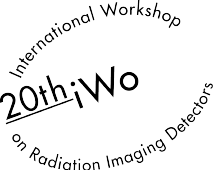Speaker
Description
Evaluating the effectiveness of a mixed lead(Ⅱ) iodide and oxide semiconductor-based sensor for the development of a position sensitive detector for tracking a radioactive source
Ye Ji Heo1, Kyo Tae Kim2, Moo Jae Han3, Yo Han Shin3, Ji Koon Park2 and Sung Kwang Park1
- Department of Radiation Oncology, Busan Paik Hospital, Inje University, Republic of Korea
- Department of Radiological science, International University of Korea, Republic of Korea
- Department of Radiation Oncology, Collage of medicine, Inje university, Republic of Korea
Radiation sources are being constantly used around the world, not only in the field of industry but also in medical radiation therapy. The radiation sources present a high risk of exposure due to their high emission energy. Therefore, a position-sensitive detection technology capable of accurate measurement is required, by increasing the sensitivity to the point of the radiation source. Conventional detectors are mostly prepared with PIN type silicon detectors, where P-type and S-type substances are doped on intrinsic silicon wafers. These silicon-based detectors cause defects in the silicon lattice when a radiation energy of 1 MeV or more is incident, thus degrading the detection efficiency.[1] Also, the lowered detection efficiency due to the silicon lattice defect can lead to potential radiation accidents, since it is impossible to accurately locate the radiation source. Hence, in this study, a Lead(Ⅱ) iodide (PbI_2) semiconductor, which exhibits excellent characteristics against the detection of gamma-ray and high-energy X-ray, was combined with Lead mono oxide (PbO), which exhibits sensitivity for high-energy radiation and low drift current characteristics, to manufacture a sensor using a screen printing method.[2,3] Also, a Silicon dioxide (SiO_2) deposition was performed to reduce the leakage current, which is caused by the movement of carrier inside the manufactured sensor, while improving the stability of signal detection. For the evaluation of the sensor developed in this study, iridium 192 (IR-192), a gamma-ray radiation source, was used. First, a morphological evaluation of the sensor was conducted. Second, an leakage current according to driving voltage change (I-V) test at the driving voltage ranging from -1000V to 1000V, and a photon current according to driving voltage change (V-S) test according to the changes in the driving voltage were conducted to obtain the signal to noise ratio (SNR). Based on the results, an effective driving voltage, at which the SNR is maximized, was derived to select an optimum driving voltage for the evaluation of energy characteristics. Third, as the items for the evaluation of detector characteristics with respect to the energy being emitted, reproducibility, linearity of the dosimeter response, and percentage internal distance (PID) were assessed to evaluate the effectiveness of the detector.
First, the result of the I-V test was 0.09±0.19 nA, and the result of the V-S test was -0.10±12.47 nA. The result of SNR analysis based on the above results was @ - 400, which was thus selected as the optimum driving voltage for the evaluation of energy characteristics. The result of reproducibility evaluation, conducted based on the selected driving voltage, was 0.15%, as a result of a standard deviation analysis of the signal currents. The linearity of the dosimeter response was analyzed by the R-Sq value of the linear regression function, and the value was 0.98 or above, indicating an excellent linearity. Finally, in the evaluation of the PID, based on the result of a linear attenuation coefficient analysis and the result of I-V test, the effective detection distance was derived as 10 cm. Therefore, the sensor developed in this study was found to have characteristics suitable for monitoring the position of radionuclides used in medical radiology. Also, further studies are required to enhance the sensitivity by increasing the effective detection distance.
References
[1] Z. Li, “Radiation damage effects in Si materials and detectors and rad-hard Si detectors for SLHC”, JINST 4 03011, 2009.
[2] J. F Condeles, T. M. Marins, et al., Fabrication and characteriazation of thin films of PbI2 for medical imaging, crystalline solids, 2004, Vol 338-340.
[3] K. T Kim, M. J. Han et al, Feasibility study of a lead monoxide based dosimeter for quality assurance in radiotherapy, JINST 11 P11006, 2016.
